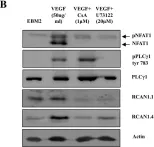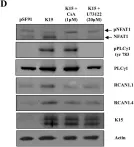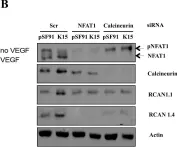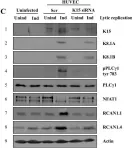Several autoimmune diseases including multiple sclerosis (MS) cause increased transcription of endogenous retroviruses (HERVs) normally repressed by heterochromatin. In parallel, HERV-derived sequences were reported to drive gene expression. Here, we have examined a possible link between promoter and enhancer divergent transcription and the production of HERV transcripts. We find that HERV-derived sequences are in general counter-selected at regulatory regions, a counter-selection that is strongest in brain tissues while very moderate in stem cells. By exposing T cells to the pesticide dieldrin, we further found that a series of HERV-driven enhancers otherwise active only at stem cell stages can be reactivated by stress. This in part relies on peptidylarginine deiminase activity, possibly participating in the reawakening of silenced enhancers. Likewise, usage of HERV-driven enhancers was increased in myelin-reactive T cells from patients with MS, correlating with activation of nearby genes at several sites. Altogether, we propose that HERV-driven enhancers constitute a reservoir of auxiliary enhancers transiently induced by stress while chronically active in diseases like MS.
© 2019 The Authors.
Product Citations: 7
Expression of endogenous retroviruses reflects increased usage of atypical enhancers in T cells.
In The EMBO Journal on 17 June 2019 by Azebi, S., Batsche, E., et al.
-
Immunology and Microbiology
Tracing MYC Expression for Small Molecule Discovery.
In Cell Chemical Biology on 16 May 2019 by Steinberger, J., Robert, F., et al.
Our inability to effectively "drug" targets such as MYC for therapeutic purposes requires the development of new approaches. We report on the implementation of a phenotype-based assay for monitoring MYC expression in multiple myeloma cells. The open reading frame (ORF) encoding an unstable variant of GFP was engineered immediately downstream of the MYC ORF using CRISPR/Cas9, resulting in co-expression of both proteins from the endogenous MYC locus. Using fluorescence readout as a surrogate for MYC expression, we implemented a pilot screen in which ∼10,000 compounds were prosecuted. Among known MYC expression inhibitors, we identified cardiac glycosides and cytoskeletal disruptors to be quite potent. We demonstrate the power of CRISPR/Cas9 engineering in establishing phenotype-based assays to identify gene expression modulators.
Copyright © 2019 Elsevier Ltd. All rights reserved.
-
WB
In Methods in Molecular Biology (Clifton, N.J.) on 12 September 2018 by Carretta, M. D., Hidalgo, M. A., et al.
Flow cytometry is a powerful technology to assess the presence of NFAT in the nuclei after CRAC channel activation. Here we described a simplified procedure for the analysis of CRAC channel activity using NFAT nuclear translocation by flow cytometry, based on the isolation of Jurkat E6-1 cell nuclei.
-
Biochemistry and Molecular biology
Preprint on BioRxiv : the Preprint Server for Biology on 19 March 2018 by Azebi, S., Batsche, E., et al.
h4>Summary/h4> Multiple sclerosis (MS) is a neuroinflammatory and autoimmune disease, in which various immune cell types and autoreactive T cells exert a pathogenic activity. This disease is also associated with increased transcription of several endogenous retroviruses (HERVs) normally kept in check by heterochromatin. Here, we have uncovered an organic pollutant dieldrin that activates several HERVs associated with MS and allowing us to examine the mechanism of their activation. Dieldrin singles out by its ability to simultaneously activate the MAP kinase and the PI3K pathways, while also triggering calcium dependent peptidylarginine deiminase activity. It was this association of pathways that caused HERV activation, a phenomenon that was only part of more generally increased transcription of heterochromatic regions. The HERV transcripts were generally not polyadenylated. Some arose as a consequence of activation of HERV-based enhancers, while others were the result of unusually strong activation at some mostly transcription factor genes causing transcription to leak out of the HERV-free region that surrounds them. Altogether, our data emphasized the hazard associated with simultaneous activation of multiples signaling pathways by xenobiotics, while also providing a very general toolbox for the interpretation of HERV transcription.
-
WB
-
Homo sapiens (Human)
-
Biochemistry and Molecular biology
In Clinical Chemistry on 1 November 2017 by Noceti, O., Pouché, L., et al.
We sought to evaluate, in patients on a liver transplantation waiting list, potential biomarkers of the base calcineurin pathway activity with use of a new model of nonstimulated peripheral blood mononuclear cells (PBMC) and ex vivo response to tacrolimus (TAC).
The calcineurin pathway activity was explored ex vivo in stimulated and nonstimulated PBMC from 19 patients. The inhibition of NFAT1 translocation to PBMC nuclei, expression of intracellular IL-2, and membrane CD25 in different T-cell subsets were measured by multiparametric flow cytometry before and after exposure to TAC. We also studied the influence on the individual response of polymorphisms in 3 key genes of the calcineurin pathway: PPIA, PPP3CA, and IL2RA.
All pharmacodynamics profiles closely fitted an I/Imax sigmoid model. Interindividual variability was higher in nonstimulated than in stimulated conditions, as well as in the presence of TAC. IL-2+CD8+ cells at TAC Imax showed the highest interindividual variability, suggesting its usefulness as a biomarker of individual TAC effects integrating many different sources of regulation and variability. Moreover, in the absence of TAC, patients with end-stage liver disease exhibited lower NFAT1 translocation and T-cell activation than healthy volunteers from a previous study under similar conditions. Multivariate statistical analysis showed strong and significant associations between TAC pharmacodynamic parameters and 2 polymorphisms in the gene-coding cyclophilin A (rs8177826 and rs6850).
We show the feasibility of using nonstimulated PBMCs to explore the calcineurin pathway under more physiologic conditions and point toward potential biomarkers for TAC pharmacodynamic monitoring. ClinicalTrials.gov Identifier: NCT01760356.
© 2017 American Association for Clinical Chemistry.
-
Chemistry
In PLoS Pathog on 1 September 2012 by Bala, K., Bosco, R., et al.
Fig.4.B

-
WB
-
Collected and cropped from PLoS Pathog by CiteAb, provided under a CC-BY license
Image 1 of 4
In PLoS Pathog on 1 September 2012 by Bala, K., Bosco, R., et al.
Fig.4.D

-
WB
-
Collected and cropped from PLoS Pathog by CiteAb, provided under a CC-BY license
Image 1 of 4
In PLoS Pathog on 1 September 2012 by Bala, K., Bosco, R., et al.
Fig.5.B

-
WB
-
Collected and cropped from PLoS Pathog by CiteAb, provided under a CC-BY license
Image 1 of 4
In PLoS Pathog on 1 September 2012 by Bala, K., Bosco, R., et al.
Fig.10.C

-
WB
-
Collected and cropped from PLoS Pathog by CiteAb, provided under a CC-BY license
Image 1 of 4



